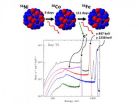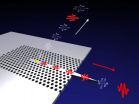(Press-News.org) A group of astrophysicists, including researchers from MIPT, have detected the formation of radioactive cobalt during a supernova explosion, lending credence to a corresponding theory of supernova explosions. Details are given in the journal Nature, one of the most cited scientific publications in the world.
The article's main author, Yevgeny Churazov (Space Research Institute of the Russian Academy of Sciences), together with his co-authors, including Sergei Sazonov of the Space Research Institute and MIPT, reported the results of their analysis of data collected with the INTEGRAL gamma-ray orbital telescope, which they used to detect the radioactive isotope cobalt-56(56Co).
Isotope 56Co has a half-life of just 77 days, and does not exist in normal conditions. However, during a giant thermonuclear explosion of a supernova, this short-lived radioactive isotope is produced in large quantities.
Radiating cobalt was registered at the supernova SN2014J, located 11 million light-years from Earth
Astrophysicists never obtained similar spectra before. The reason was the rarity of explosions at such a distance – 11 million light-years is a large value on the galactic scale (the diameter of a galaxy is about 100,000 light-years, the distance between stars is a few light-years), but on an intergalactic scale it is a relatively short distance. There are several hundreds of galaxies within a radius of ten million light-years; supernovae produce explosions like this (type Ia explosions) once every few centuries in a galaxy. For example, a type Ia supernova last exploded in the Milky Way in 1606.
SN2014J was registered on January 21, 2014 by astronomer Steve Fossey and a group of students from University College London in the galaxy M82. Fossey reported the discovery, and several observatories, including INTEGRAL, started observations immediately. Russian researchers spent a million seconds of their quota for the use of the INTEGRAL telescope to study the supernova. In addition to the spectra, they obtained data on how the brightness of radiation changes over time.
According to a theory that was developed earlier, during an explosion of the Ia type, the remnants of a star barely radiate in the gamma range the first dozens of days. The star's shell is opaque in this region of the spectrum; a supernova begins to produce gamma radiation only after the outer layer becomes sufficiently rarefied. By that time, radioactive nickel-56 with a half-life of 10 days, synthesized during the explosion, transforms into radioactive cobalt-56, the lines of which were detected by the researchers.
The essence of spectral analysis remains unchanged whatever the nature of radiation. For light, X-rays and even radio waves, scientists first plot a graph of a spectrum, or the relationship of intensity and frequency (or, equivalently, wavelength: wavelength is inversely proportional to frequency).
The graph's shape indicates the nature of the source of radiation and through what environment the radiation has passed. Spectral lines, or sharp peaks on such graphs, correspond to certain events like the emission or absorption of quanta by atoms during transition from one energy level to another.
During formation, cobalt-56 had a surplus of energy, exhausted in the form of gamma rays with energies of 847 keV and 1237keV; other isotopes produced radiation with quanta of different energies and thus could not be confused with cobalt-56.
The data collected by the INTEGRAL telescope also allowed the researchers to assess how much radioactive cobalt was emitted during the explosion – the equivalent of about 60% of the Sun's mass.
Over time, cobalt-56 turns into the most common isotope of iron, 56Fe.56Fe is the most common isotope because it can be obtained from nickel emitted during supernovae explosions (nickel turns into cobalt, and cobalt turns into iron).
Thus, the new results back up simulations of supernovae explosions and also confirm that our planet consists of matter that has gone through thermonuclear explosions of an astronomical scale.
INFORMATION:
Astrophysicists report radioactive cobalt in supernova explosion
A group of Russian astrophysicists have detected the formation of radioactive cobalt during a supernova explosion, lending credence to a corresponding theory of supernova explosions
2014-08-29
ELSE PRESS RELEASES FROM THIS DATE:
Cellphone addiction 'an increasingly realistic possibility,' Baylor study finds
2014-08-29
Women college students spend an average of 10 hours a day on their cellphones and men college students spend nearly eight, with excessive use posing potential risks for academic performance, according to a Baylor University study on cellphone activity published in the Journal of Behavioral Addictions.
"That's astounding," said researcher James Roberts, Ph.D., The Ben H. Williams Professor of Marketing in Baylor's Hankamer School of Business. "As cellphone functions increase, addictions to this seemingly indispensable piece of technology become an increasingly realistic ...
'K-to-M' histone mutations: How repressing the repressors may drive tissue-specific cancers
2014-08-29
Kansas City, MO. - In a cell's nucleus, chromosomal DNA is tightly bound to structural proteins known as histones, an amalgam biologists call chromatin. Until about two decades ago, histones were regarded as a nuclear "sidekick," the mere packing material around which the glamorous DNA strands were wrapped. Recently, however, biologists have developed a greater appreciation for how DNA/histone interactions govern gene expression.
In 2012, investigators from multiple research institutions studying the sequence of the genome from cancer patients rocked the "chromatin world" ...
Copper shines as flexible conductor
2014-08-29
Bend them, stretch them, twist them, fold them: modern materials that are light, flexible and highly conductive have extraordinary technological potential, whether as artificial skin or electronic paper.
Making such concepts affordable enough for general use remains a challenge but a new way of working with copper nanowires and a PVA "nano glue" could be a game-changer.
Previous success in the field of ultra-lightweight "aerogel monoliths" has largely relied on the use of precious gold and silver nanowires.
By turning instead to copper, both abundant and cheap, ...
Meaningful relationships can help you thrive
2014-08-29
In brief:
The definition of thriving involves 5 components of well-being
Relationships provide 2 types of support: source of strength (SOS) support, and relational catalyst (RC) support
Support-providers must be sensitive and responsive—there are characteristics in a support-provider that can lead to doing more harm than good
Future research should focus more on social support in non-adverse life circumstances
Deep and meaningful relationships play a vital role in overall well-being. Past research has shown that individuals with supportive and rewarding relationships ...
Plug n' play protein crystals
2014-08-29
Almost a hundred years ago in 1929 Linus Pauling presented the famous Pauling's Rules to describe the principles governing the structure of complex ionic crystals. These rules essentially describe how the arrangement of atoms in a crystal is critically dependent on the size of the atoms, their charge and type of bonding. According to scientists from the Biohybrid Materials Group of Aalto University Finland led by Mauri Kostiainen similar rules can be applied to prepare ionic colloidal crystals consisting of oppositely charged proteins and virus particles. The results can ...
Managing coasts under threat from climate change and sea-level rise
2014-08-29
Coastal regions under threat from climate change and sea-level rise need to tackle the more immediate threats of human-led and other non-climatic changes, according to a team of international scientists.
The team of 27 scientists from five continents, led by Dr Sally Brown at the University of Southampton, reviewed 24 years of Intergovernmental Panel on Climate Change (IPCC) assessments (the fifth and latest set being published in 2013 and 2014). They focused on climate change and sea-level rise impacts in the coastal zone, and examined ways of how to better manage and ...
Mobile app on emergency cardiac care aids best decisions in seconds
2014-08-29
Barcelona, Spain –Saturday 30 August 2014: The ACCA Clinical Decision-Making Toolkit mobile app is now available on the App Store and Google Play.
When dealing with acute cardiovascular diseases, a few seconds can make the difference and instant access to the best recommendations can save lives. This led the Acute Cardiovascular Care Association (ACCA) of the ESC to develop a user friendly interactive application, allowing professionals to have immediate access to diagnostics pathways on their mobile devices.
The Toolkit on emergency cardiac care, first published as ...
Breakthrough in light sources for new quantum technology
2014-08-29
Electronic circuits are based on electrons, but one of the most promising technologies for future quantum circuits are photonic circuits, i.e. circuits based on light (photons) instead of electrons. First, it is necessary to be able to create a stream of single photons and control their direction. Researchers around the world have made all sorts of attempts to achieve this control, but now scientists at the Niels Bohr Institute have succeeded in creating a steady stream of photons emitted one at a time and in a particular direction. The breakthrough has been published in ...
Real tremors, or drug-seeking patient? New app can tell
2014-08-29
A 42-year-old investment banker arrives at the emergency department with complaints of nausea, vomiting, anxiety and tremor. He drinks alcohol every day—often at business lunches, and at home every evening. Worried about his health, he decided to quit drinking and had his last Scotch 24 hours before coming to emergency.
It's a common scenario in emergency rooms across Canada—a patient suddenly stops regular, excessive alcohol consumption and develops withdrawal.
Withdrawal is a potentially fatal condition that is easily treated with benzodiazepine drugs, a class of ...
Socioeconomic status and gender are associated with differences in cholesterol levels
2014-08-29
A long-term lifestyle study reports differences between the sexes when it comes to fat profiles associated with socioeconomic status. Research in the open access journal BMC Public Health breaks down factors associated with social class and finds surprising inequalities between men and women.
The researchers found that men in social classes (based on occupation) with manual jobs had lower cholesterol levels than their counterparts in non-manual social classes. In contrast, women's LDL-cholesterol levels were more closely tied to their educational level than men.
The ...
LAST 30 PRESS RELEASES:
Numbers in our sights affect how we perceive space
SIMJ announces global collaborative book project in commemoration of its 75th anniversary
Air pollution exposure and birth weight
Obstructive sleep apnea risk and mental health conditions among older adults
How talking slows eye movements behind the wheel
The Ceramic Society of Japan’s Oxoate Ceramics Research Association launches new international book project
Heart-brain connection: international study reveals the role of the vagus nerve in keeping the heart young
Researchers identify Rb1 as a predictive biomarker for a new therapeutic strategy in some breast cancers
Survey reveals ethical gaps slowing AI adoption in pediatric surgery
Stimulant ADHD medications work differently than thought
AI overestimates how smart people are, according to HSE economists
HSE researchers create genome-wide map of quadruplexes
Scientists boost cell "powerhouses" to burn more calories
Automatic label checking: The missing step in making reliable medical AI
Low daily alcohol intake linked to 50% heightened mouth cancer risk in India
American Meteorological Society announces Rick Spinrad as 2026 President-Elect
Biomass-based carbon capture spotlighted in newly released global climate webinar recording
Illuminating invisible nano pollutants: advanced bioimaging tracks the full journey of emerging nanoscale contaminants in living systems
How does age affect recovery from spinal cord injury?
Novel AI tool offers prognosis for patients with head and neck cancer
Fathers’ microplastic exposure tied to their children’s metabolic problems
Research validates laboratory model for studying high-grade serous ovarian cancer
SIR 2026 delivers transformative breakthroughs in minimally invasive medicine to improve patient care
Stem Cell Reports most downloaded papers of 2025 highlight the breadth and impact of stem cell research
Oxford-led study estimates NHS spends around 3% of its primary and secondary care budget on the health impacts of heat and cold in England
A researcher’s long quest leads to a smart composite breakthrough
Urban wild bees act as “microbial sensors” of city health.
New study finds where you live affects recovery after a hip fracture
Forecasting the impact of fully automated vehicle adoption on US road traffic injuries
Alcohol-related hospitalizations from 2016 to 2022
[Press-News.org] Astrophysicists report radioactive cobalt in supernova explosionA group of Russian astrophysicists have detected the formation of radioactive cobalt during a supernova explosion, lending credence to a corresponding theory of supernova explosions





